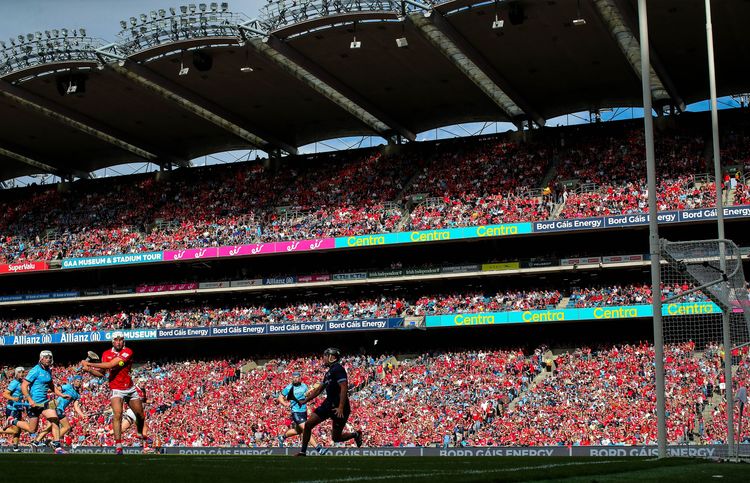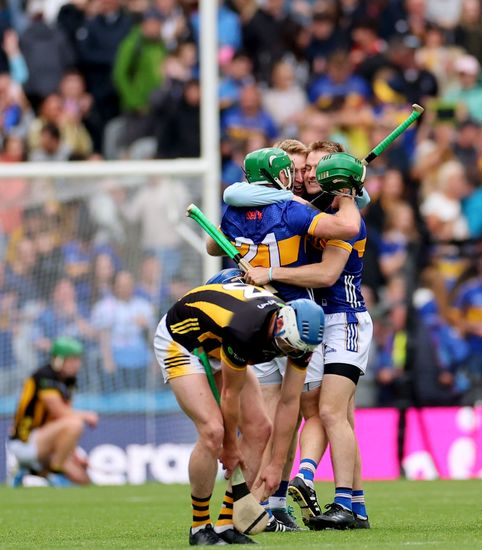[caption id="attachment_70254" align="aligncenter" width="600" caption="Terence MacSwiney."]
On the morning of August 23rd, 1920, Day 11 of Terence MacSwiney's hunger strike, a Broadway actress named Eileen Curran, accompanied by her friends, Helen Crowe and Helen Merriam, arrived outside the British Consulate at 44 Whitehall Street in New York.
Bent on launching a protest vigil, Miss Curran had adapted the words of a well-known English ballad called "Trelawney," and printed them on a placard two and a half feet long by three feet wide. It read: "And shall MacSwiney die? And shall MacSwiney die? There's twenty million Irishmen
Who'll know the reason why."
Carrying that banner aloft, she began marching up and down the street outside the consulate. Behind her in this brief parade, Miss Crowe was waving a placard of her own, asking the pertinent question: "Are two Mayors of Cork to be murdered in six months to sustain British rule in Ireland?"
Soon, the trio was joined in this demonstration by half a dozen more women, some of them carrying signs, including one detailing the murder of MacSwiney's predecessor, Tomas MacCurtain.
For a time, a crowd of a couple of hundred onlookers gathered to see what the fuss was all about. Police officers came upon the scene as well, but there was no hint of disorder to the proceedings.
Three thousand miles from where MacSwiney's health continued to falter in Brixton Prison, his cause was being advertised and explained on the streets of Manhattan. More significant yet, this picket garnered plenty of New York newsprint because the hunger strike had become a staple of the headlines, and would remain a front page regular over the next two months.
When reporters asked who exactly was behind these protests, Dr. Gertrude B. Kelly, a Waterford native, a surgeon, and a well-known figure in the Irish Republican movement in Manhattan, answered: "American women."
Their nationality counted for little on the second day of their picket when somebody in the U.S. Navy office, located in the same building as the British Consulate, dumped a bucket of water on the ladies from on high.
At around the same time the naval miscreant was dousing one set of the distaff protesters, another delegation from the group, which went by the official title "the American Women's Pickets for the Enforcement of America's War Aims," was in Washington for a sit-down with Secretary of State Bainbridge Colby.
They urged Colby to use his influence with the British government to try to effect MacSwiney's release from jail. When he replied he could guarantee nothing but would take that request under advisement, the women answered: "Taking the matter under advisement would be regarded by half a million American women as an evasion equivalent to positive negation."
Following the meeting with Colby, the women dispatched identical telegrams to Governor James Cox, Senator Warren Harding, and Parley Christensen, the respective presidential candidates from the Democratic, Republican, and Farmer-Labor Parties. Brief and to the point, they asked the nominees "if the principle of self-determination for which we went to war is a reason for deporting a man from his own country and murdering him in prison."
All of these worthy gestures were merely a preamble to the events of August 27th. When the SS Baltic, the White Star liner from which Archbishop Mannix had been so hastily removed by British soldiers to prevent him landing in Ireland earlier in the summer, cruised into New York harbor, these ladies recognized a unique opportunity to garner more publicity for their cause.
Even before the ship came into sight of its berth at Pier 59 that day, the pickets began milling around the docks, asking longshoremen to down tools and to refuse to unload its cargo.
They were asking the workers to walk out on two counts: Revenge for Mannix and justice for MacSwiney. Their dual mandate was evident from the placards they carried, and the sheets of paper they distributed outlining the ill-treatment of the bishop and the plight of the mayor in faraway Brixton. Arriving on the waterfront just in time to coincide with lunch break, they beseeched every employee they met: "Quit your jobs now, and we will tie up every British ship in this port."
"Will you stand back and see MacSwiney killed by the British Premier, shouted one of the protesters. "Will you see the Mayor of Cork suffer in jail?"
"No, no, no!" replied her fellow-travelers.
Once the Baltic had docked and disgorged its passengers, the demonstrators infiltrated Pier 59 itself in an almost comical scene.
"Where do you think you are going?' asked the customs guard
at the gate.
"Oh," replied one of the women, "we just want to get a peep at the big ships."
Before the security men could respond, the women, already heading up a phalanx of over 100 longshoremen, were on their way through. They occupied a space in between the Baltic and another vessel, the Olympic. One of the ladies then clambered onto the back of a truck to deliver an impassioned speech, appealing to those working the ship to walk off the job and join the protest. By some estimates, around 100 coal stokers immediately did just that. They were soon joined by twice that number of longshoremen.
Between first and second generation immigrants, the docks were such an Irish stronghold in New York then that workers were often divided up into gangs along the lines of county allegiances. Most who worked there were avid members of the Ancient Order of Hibernians, committed supporters of the physical force brand of nationalism, and generous contributors to the myriad collections for Irish causes that were taken up on a regular basis.
Even still, it was impressive that 500 or so of them were that quick to give up a day's pay in a job where work wasn't always guaranteed, in order to row in behind what the papers would dub "The Irish Patriotic Strike."
It wasn't just the Irish who were moved by the pleas either. At the Cunard and Red Star piers, several hundred more joined the throng and the most notable addition was the arrival, as noted by the following day's New York Times, of "100 negro longshoremen who were employed in loading the steamer 'Norman Monarch.'"
For nearly three quarters of a century, the Irish and the African Americans had been at loggerheads along the docks, their relationship a potent brew of strike-breaking, territorial squabbles, and racial tension that occasionally turned deadly.
The willingness of black dockers to throw their lot in with a protest organized by people with whom they'd had so much trouble sums up the impact the MacSwiney case was having in America.
This type of ecumenism was, however, just in keeping with the mood of the day. At the Anchor Line facility, a similar story unfolded as dozens of workers left the liner, Calabria, and two freighters moored alongside.
Having started with a group of well-intentioned women on 19th Street in Chelsea, the cavalcade mushroomed into the thousands en route to 44th Street where two more freighters, one bearing the Union Jack, the other the French tricolor, were soon embroiled in this impromptu industrial action.
"Few if any developments in the entire history of the New York waterfront could equal, or explain, this extraordinary event and the convergence of class, nationalist and racial slogans it generated," wrote Bruce Nelson. "In this case, 'British' coal passers, many of them wearing small American flags on their coats, stopped work in support of the 'Irish Republic' and black longshoremen shouted "Free Africa' as they joined the strike."
Although it appeared organic and spontaneous, and was reported as such by the papers the next day, the entire production had been meticulously organized over the previous week.
Helen Golden, another actress and veteran of the Whitehall Street protest, had planned the whole affair with the help of leading Irish Republicans in the city. They had kept their intentions so clandestine that most of the women turned up that Friday morning unsure of what exactly they would be doing at the piers.
"Well we did it," said Eileen Curran. "We're trying to show the English that American women of Irish birth can keep them busier than they've ever been in their lives. Let them release MacSwiney and then we'll begin a new effort to compel them to let Archbishop Mannix into Ireland."
Emboldened by the success of the venture, the group immediately cabled a message to Lloyd George: "The sound of death in the throat of Terence MacSwiney is the death knell of your adventure in Ireland. We hear the bells tolling. The people are gathering. Oil your tanks, polish up your guns."
As the clock in Brixton Prison ticked into the late evening of MacSwney's fifteenth night without food, New York's waterfront thrummed to the sound of his cause.
With over 2000 men having departed their posts, and every British ship on the North River paralyzed by the stoppage, James Lynch, an organizer with the Marine Firemen, Oilers and Watertenders Union, told reporters that men working every British ship from Galveston, Texas in the south to Portland, Oregon in the west would be asked to do likewise.
If that ambition proved to be a tad optimistic, over the next couple of weeks, smaller strikes broke out, amongst other places, across the river in Hoboken, New Jersey and up the coast in Boston. For a couple of weeks, the protest seriously hampered traffic, slowed down loading and unloading of ships in New York, and demonstrated how much Americans of Irish extraction empathized with MacSwiney's plight.
Dave Hannigan's book "Terence MacSwiney: The Hunger Strike that Rocked an Empire." is published by The O'Brien Press and is available online..









